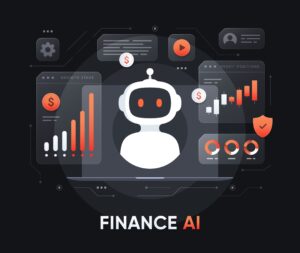
(denvitruk/Shutterstock)
AI has swept through nearly every sector, and now finance is in the midst of its AI moment, with promises to revolutionize critical processes like credit decisioning and risk assessment. One of the biggest differences is that the margin for error in finance is razor-thin. A misclassified transaction can trigger a wrongful loan denial. A biased algorithm can perpetuate systemic inequities. A security breach can expose millions of customers’ most sensitive data.
That’s not stopping organizations from diving in headfirst to see what AI can do for them. According to KPMG, nearly 88% of American companies are using AI in finance, with 62% implementing it to a moderate or large degree. Yet few are truly optimizing its potential. In order to get the most out of AI, which usually means scaling, institutions have to do so responsibly. While other industries can afford to iterate and learn from mistakes, finance demands getting it right from the start.
The stakes are fundamentally different here. When AI fails in finance, it doesn’t just inconvenience users or deliver subpar results. It affects people’s ability to secure housing, start businesses, or weather financial emergencies. These consequences demand a different approach to AI implementation, one where accuracy, fairness, and transparency aren’t afterthoughts but foundational requirements.
Here’s what leaders at financial institutions need to consider as they progress with their AI deployments.
Building AI at scale without cutting corners
McKinsey once predicted that AI in banking could deliver $200-340 billion in annual value “if the use cases were fully implemented.” But you can’t get there overnight. Scaling from a promising model trained on a small dataset to a production-ready system serving thousands of API calls daily requires engineering discipline that goes far beyond initial prototyping.

(Gumbariya/Shutterstock)
First you need to understand where your data is currently stored. Once you know its location and how to access it, the real journey begins with data preprocessing, arguably the most critical and overlooked phase. Financial institutions receive data from multiple providers, each with different formats, quality standards, and security requirements. Before any modeling can begin, this data must be cleansed, secured, and made accessible to data scientists. Even when institutions specify that no personally identifiable information should be included, some inevitably slips through, requiring automated detection and masking systems.
The real complexity emerges when transitioning from model training to deployment. Data scientists work with small, curated datasets to prove a model’s viability. But taking that prototype and deploying it through automated pipelines where no human intervention occurs between data input and API response demands a completely different engineering approach.
API-first design becomes essential because it delivers consistency and standardization — ensuring clear contracts, uniform data structures, and reliable error handling. This approach allows parallel development across teams, makes systems easier to extend, and provides a stable contract for future integrations. This repeatability is crucial for financial applications like assessing credit risk, generating cash flow scores, or evaluating financial health summaries, and separates experimental AI from production-grade systems that can handle thousands of simultaneous requests without compromising accuracy or speed.
Guarding against bias and unfair outcomes
Financial AI faces a unique challenge in that traditional financial data can perpetuate historical inequities. Traditional credit scoring has systematically excluded certain populations, and without careful feature selection, AI models can amplify these biases.
The solution requires both technical rigor and ethical oversight. During model development, features like age, gender, and other demographic proxies must be explicitly excluded, even if traditional thinking says they correlate with creditworthiness. Models excel at finding hidden patterns, but they cannot distinguish between correlation and causation or between statistical accuracy and social equality.
Thin-file borrowers illustrate this challenge perfectly. These individuals lack traditional credit histories but may have rich transaction data demonstrating financial responsibility. A 2022 Consumer Financial Protection Bureau analysis found that traditional models resulted in a 70% higher probability of rejection for thin-file consumers who were actually low-risk, a group termed “invisible primes.”

(Phongphan/Shutterstock)
AI can help expand access to credit by analyzing non-traditional, transaction-level data like salary patterns, spending behaviors, and money movements between accounts. But this requires sophisticated categorization systems that can parse transaction descriptions. When someone makes a recurring transfer to a savings account or a recurring transfer to a gambling platform, the transaction patterns may look similar, but the implications for creditworthiness are vastly different.
This level of categorization requires continuous model refinement. It takes years of iteration to achieve the accuracy needed for fair lending decisions. The categorization process becomes increasingly intrusive as models learn to distinguish between different types of financial behavior, but this granular understanding is essential for making equitable credit decisions.
The overlooked dimension: security
While many financial institutions talk about AI adoption, fewer discuss how to secure it. The enthusiasm for “AI adoption” and “agentic AI” has overshadowed fundamental security considerations. This oversight becomes particularly dangerous in SaaS environments where anyone can sign up for AI services.
Regulations alone won’t solve the risks of misuse or data leakage. Proactive governance and internal controls are critical. Financial institutions need clear policies defining acceptable AI use, like ISO standards and SOC 2 compliance. Data privacy and handling protocols are also crucial in protecting customers’ financial information.
Technology built for good can easily become a tool for bad actors. Sometimes, technologists don’t fully consider the potential misuse of what they create. According to Deloitte’s Center for Financial Services, AI could enable fraud losses to reach $40 billion in the U.S. by 2027, more than triple 2023’s $12.3 billion in fraud losses. The financial sector must maintain vigilance about how AI systems can be compromised or exploited.
Where responsible AI can move the needle
Used responsibly, AI can broaden access to fairer lending decisions by incorporating transaction-level data and real-time financial health signals. The key lies in building explainable systems that can articulate their decision-making process. When an AI system denies or approves a loan application, both the applicant and the lending institution should understand why.
This transparency satisfies regulatory requirements, enables institutional risk management, and builds consumer trust. But it also creates technical constraints that don’t exist in other AI applications. Models must maintain interpretability without sacrificing accuracy, a balance that requires careful architecture decisions.
 Human oversight must also remain essential. A 2024 Asana report found that 47% of employees worried their organizations were making decisions based on unreliable information gleaned from AI. In finance, this concern is of existential importance. The goal is not to slow down AI adoption but to ensure that speed doesn’t compromise judgment.
Human oversight must also remain essential. A 2024 Asana report found that 47% of employees worried their organizations were making decisions based on unreliable information gleaned from AI. In finance, this concern is of existential importance. The goal is not to slow down AI adoption but to ensure that speed doesn’t compromise judgment.
Responsible scaling means building systems that augment human decision-making rather than replacing it entirely. Domain experts who understand both the technical capabilities and limitations of AI models, as well as the regulatory and business context in which they operate, must be empowered to intervene, question, and override AI decisions when circumstances warrant.
AI adoption may be accelerating across finance, but without explainability, fairness, and security, we risk growth outpacing trust. The next wave of innovation in finance will be judged not just on technological sophistication but on how responsibly firms scale these capabilities. The institutions that earn the trust of customers will be those that understand that how you scale matters as much as how quickly you do it.
About the author: Rajini Carpenter, CTO at Carrington Labs, has more than 23 years’ experience in Information Technology and the finance industry, with expertise across IT Security, IT Governance & Risk, and Architecture & Engineering. He has led the development of world-class technology solutions and customer-centered client experiences, previously holding the roles of VP of Engineering at Deputy and Head of Engineering, Wealth Management at Iress, prior to joining Beforepay. Rajini is also a Board Director at Judo NSW.
Related Items
Deloitte: Trust Emerges as Main Barrier to Agentic AI Adoption in Finance and Accounting
AI in Finance Summit London 2025
How AI and ML Will Change Financial Planning
AI, AI finance, banking, bias, finance, financial, financial sector, genAI finance, KPMG, scale, scaling AI

